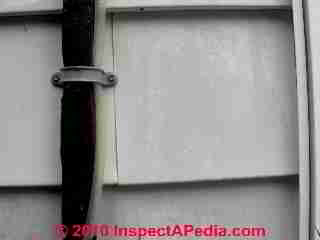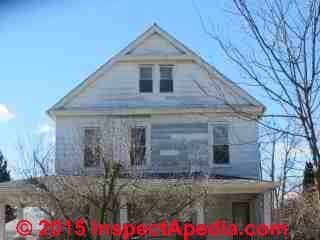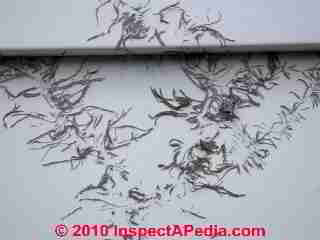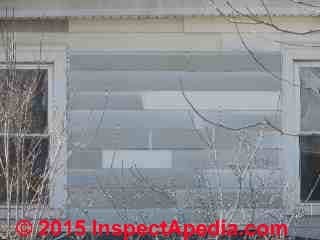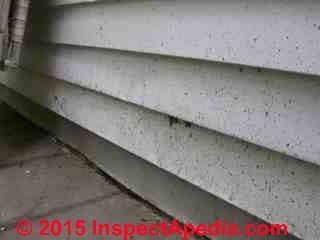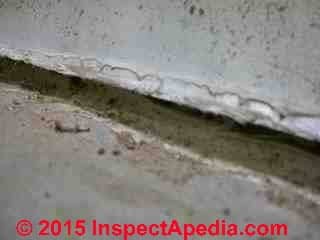 Aluminum Siding Defects, Diagnosis, Repair
Aluminum Siding Defects, Diagnosis, Repair
How to inspect, install, repair, clean or paint old aluminum siding
- POST a QUESTION or COMMENT about aluminum siding on buildings
Aluminum siding inspection, installation, diagnosis, repair, cleaning or painting:
This article discusses the identification, history, and common defects observed in aluminum exterior building siding, such as weathering, paint loss, dents, and questions about the need for a vapor barrier behind asphalt siding and over building sheathing. Included are comments from several recognized building inspection and construction authorities.
Our page top photograph shows 1960's vintage (wideboard) aluminum building siding installed over peeling deteriorated wood clapboards on a pre-1900 home in Poughkeepsie, NY.
InspectAPedia tolerates no conflicts of interest. We have no relationship with advertisers, products, or services discussed at this website.
- Daniel Friedman, Publisher/Editor/Author - See WHO ARE WE?
Aluminum Siding History, Defects, Vapor Barriers, Inspection, and Diagnosis
 Aluminum siding, produced from aluminum coil stock and painted in a wide variety of colors, provided a durable exterior building cladding that resisted rust and rot. Aluminum siding in its earlier forms was typically produced in a (roughly) 6" wide clapboard stock, installed with a fiberboard backer to resist denting in some cases.
Aluminum siding, produced from aluminum coil stock and painted in a wide variety of colors, provided a durable exterior building cladding that resisted rust and rot. Aluminum siding in its earlier forms was typically produced in a (roughly) 6" wide clapboard stock, installed with a fiberboard backer to resist denting in some cases.
Aluminum & steel building siding was very popular and widely installed in North America from the 1940's into the 1970's. By the 1970's a narrow-width aluminum siding "board" stock (shown above) was in popular use in both smooth surface forms and in embossed designs resembling wood.
Because of the large amounts of energy used to produce aluminum siding and increasing raw materials costs, aluminum siding declined in popularity in the U.S. in the 1970's.
[Click to enlarge any image]
Article Contents
- ALUMINUM SIDING DAMAGE ASSESSMENT
- BUILDING SIDING in GROUND CONTACT: buckled siding confirms insect damage or rot & structural damage
- COMPARE ALUMINUM SIDING NARROW & WIDE WIDTHS
- CLEAN or PAINT ALUMINUM SIDING
- PAINT LOSS on ALUMINUM SIDING
How to Identify Aluminum Building Siding
It's easy to distinguish between aluminum siding and vinyl siding products by careful visual inspection of the material edges or by observation of dents (aluminum) versus breaks or impact damage (vinyl).
But to distinguish between aluminum siding and it's steel look alike you may need a magnet (or you might see rust).
Aluminum Siding Damage Inspection
Building siding in ground contact: risk of insect damage or rot & structural damage
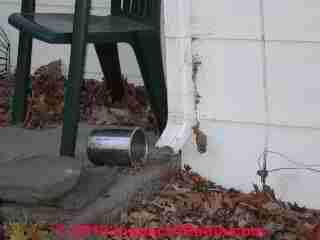
Don't install any building siding down in contact with the soil or below the soil level (below left) - doing so is inviting a hidden termite or carpenter attack. On occasion we have inspected a building whose bottom course of siding was bulged outwards.
Knowing that it would have been virtually impossible to install the siding in that form, a good guess is that the building sills and or lower walls have been damaged by rot or insect pests.
Our siding photo at below left shows a roof gutter downspout spilling right by the aluminum siding that has been buried below ground level. Adding water increases the risk of hidden insect or rot damage.
This often hidden condition and the need for possibly costly building repairs can be verified by interior inspection or by removing some exterior siding at the wall bottom. This is not a defect peculiar to aluminum, vinyl, or other siding products - you can make this mistake with any wall cladding.
Buckled Aluminum Siding at Ground Level Risks Big Trouble
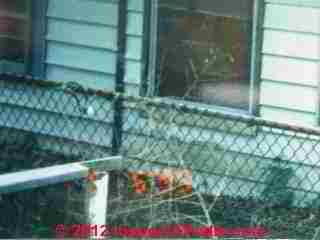 The condition of building siding may be more than a cosmetic issue. For people interested in detecting hidden building damage the photo at left is one of the more important ones we've taken.
The condition of building siding may be more than a cosmetic issue. For people interested in detecting hidden building damage the photo at left is one of the more important ones we've taken.
This aluminum siding photograph illustrates buckling aluminum siding at the wall bottom - not a defect in the siding material but a poor installation (buried in the ground) inviting insect and rot problems in the building structure.
The aluminum siding is buckled in the bottom two courses on this home but is intact on upper courses.
The building, built over an inaccessible crawl space had suffered such extreme termite damage to its sills and lower wood-framed walls that the weight of the building above had crushed and buckled the aluminum siding.
An understanding of how siding is installed on buildings (from the bottom of the wall up) would lead an observer to realize that you couldn't install buckle siding in this fashion, the damage had to occur by a downwards movement of the structure (or an earth heave which was very unlikely in this pattern).
Very extensive and costly sill and wall framing repairs were needed - an opinion confirmed when the lower siding segments were removed.
Burying just about any building exterior wall covering or siding is asking for trouble.
See SIDING CLEARANCE TO GROUND
See also VINYL SIDING BURIED at WALL BOTTOM
Aluminum Siding Details at Roof Abutments
We cite the roof-siding abutment point as a common location of rot or insect damage. While wood siding too closet to the roof surface will generally rot, aluminum or vinyl don't suffer the same risk.
However if proper step flashing was not installed under the roof shingles and against the wall under the siding, this same location becomes a roof or wall leak.
I don't like to caulk this area - it's an unreliable repair. Notice that the installer omitted any J-channel at the siding bottom edge, perhaps figuring that it wasn't necessary.
I'd take a closer look at the siding and flashing at the roof-wall abutment shown above.
Also notice how close that window sill and trim are to the roof surface? Expect to find rot at this location.
Aluminum Siding Dents & Holes
Dents in aluminum siding are essentially only a cosmetic concern, except for the more subtle case of a dent that deforms trim, flashing or sealant that permits leaks into the wall structure.
Holes in aluminum siding are likely to be serious water entry points risking hidden damage such as rot or insect attack or perhaps a costly mold contamination issue.
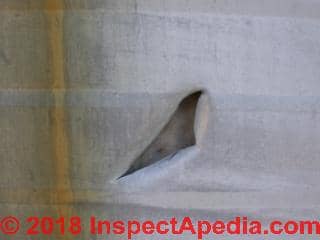
The hole in aluminum siding shown above was observed by the author [DF] at an aluminum-sided trailer in Prattsville, NY.
Below: the vertical aluminum siding on this all-metal building shows what happens when the wall is not protected from vehicles in an adjacent parking lot. Photo courtesy of InspectApedia reader SD.
Aluminum Siding Damage: Impact vs. Settlement-Buckling
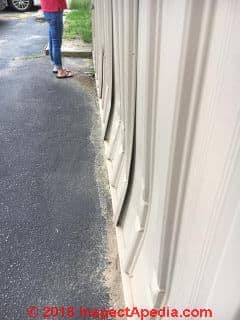 Question: Buckling getting worse at aluminum-sided commercial building
Question: Buckling getting worse at aluminum-sided commercial building
2018/05/28 SD said:
Just leased building and moved in. 2 story office building with warehouse. Buckling is noted to be getting worse. This is below offices. Should we be concerned for safety?
Reply: settling or crushing structure is important and potentially dangerous: how to investigate further
SD
I can't assess overall safety related to the condition of the building from just your photo but here are some considerations:
If the damage is from settlement of the structure, not from impact by vehicles, then the structure, perhaps wood-framed, is damaged, perhaps by rot or insect attack.
Watch out: Your observation that the siding damage seems to be getting worse, again if you're sure that nobody is bumping vehicles into the aluminum-sided wall, suggests that significant building settlement or movement is ongoing.
That is likely to ultimately require significant expense to repair.
You can confirm that the siding buckling is really due to building movement and not vehicles by
- Inspection of the building wall structure and supporting foundation or footings - you may need to remove drywall or paneling inside if there is not open access to the wall structure
- Inspection of other building walls that are not adjoined by a parking lot
If a wood-framed building framing structure is damaged enough to squash down the lower portion of metal siding as in your photo the damage is significant. The structure could be un-stable. That would be unsafe.
If the building is steel framed and the frame is damaged by rust or corrosion similar concerns apply.
If the damage is not to the framed structure but to the supporting foundations or footings the damage is significant, usually progresses more-slowly, but could be unsafe if the movement that has already occurred is sufficient to damage, break, or separate structural connections.
Comparing Aluminum Siding Wide and Narrow Widths
Our aluminum siding photo (above) provides a close up of 1960's vintage aluminum siding that is losing its paint coating.
The photo below shows a nice algae growth on this shaded, aluminum-sided building wall that was covered with a narrow-gauge wood-pattern embossed aluminum siding product in the 1980's.
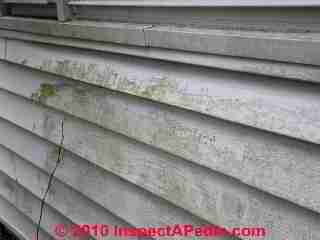
Cause & Evaluation of Paint loss on aluminum siding
Watch out: some versions of aluminum siding (especially from the 1960's) included a paint coating that weathered, chalked, and even washed off entirely, leaving a bare aluminum surface (photos below).
Besides the obvious appearance of aluminum siding that has lost its paint - shown above, even aluminum siding that has retained its white color (or other color in later siding products) may be chalky and in poor condition.
Chalking paint or paint loss on aluminum siding is caused by aging of the paint or to put it more technically: binders have been lost from the paint coating, leaving pigment that can wash or wipe away.
More about the mechanisms involved in paint failure is
Check for chalking in the paint surface
A simple field-test of the condition of the surface of older aluminum siding is to wipe a finger across the siding surface - perhaps it's best to choose an unobtrusive spot so you don't leave an ugly smear.
If your finger comes away white with oxidized paint you have an idea that the surface is deteriorating.
As the photographs below show, paint loss on older, typically wide-board aluminum siding, can be so extreme that the silver aluminum below is exposed.
The painted coating on some aluminum siding can also be "pulled" off of aluminum siding by some fungal growths (artillery fungus) and by vines (photo below).
Our aluminum siding photo (above) shows a close up of a fungal growth on an embossed aluminum siding product.
The mold growth on this siding is not a product defect, it is the result of site conditions - moisture and shade, as is the green and black algae shown on the siding in a photo earlier in this article.
Below the aluminum siding is covered by the remains of vines that were covering the building wall.
Pulling away vines from painted aluminum siding often removes paint as well.
How to Clean or Paint Aluminum Siding
Step 1: clean the aluminum siding
Aluminum siding (and other siding products) can be cleaned by power washing or by hand scrubbing. Don't be upset if scrubbing the weathered aluminum siding causes more paint-loss. That's part of proper surface preparation in that your new paint will bond better and last longer if installed on a sound, secure, surface. Painting over dirt or chalked paint surfaces may not give a lasting paint job. .
Watch out: don't spray your power washer "up" under any building siding product or you risk blowing water into the building walls, causing a mold or water damage problem.
Watch out: also don't use solvents such as acetone, lacquer thinner, or mineral spirits to clean aluminum siding in preparation for painting.
Not only are some of these solvents dangerous to handle, a run of acetone or lacquer thinner down a painted wall can leave a dissolved run-pattern that telegraphs through the new paint job
. If you already made this mistake, when the wall surface is dry, sand it lightly with 200 grit emery paper or finer. We only use a solvent, such as mineral spirits, if road tar or roof cement asphalt has been splashed onto the to-be-painted aluminum surface.
You can paint bald and balding aluminum siding but without proper surface preparation such as power-washing, the paint job won't be durable.
And power-washing to clean siding or to prepare it for painting can itself cause trouble if the power-washer is not handled properly.
Spraying "up" against the lower edges of aluminum (or vinyl) siding forces water into the building wall system and can in the worst cases soak building wall insulation or cause a costly mold contamination problem. Don't do that.
Step 2: Choose the primer and paint for aluminum siding
With careful surface preparation and selection of a paint or primer + top coat paint specifically recommended by its manufacturer for aluminum siding, it is possible to re-paint weathered aluminum siding - of course we then have converted a "no maintenance" material into one that will require occasional repainting.
The siding above is installed down to ground contact at a stone patio, offering an inviting path to termites or carpenter ants who may enter the building wall or floor framing.
The dirt and debris on the siding tells us that there is considerable rain splash-up onto these walls, adding wet conditions and increasing the risk of insect damage, leaks, or rot. In fact extensive termite damage was found in the floors of this building.
Above you can see peeling paint on the lower course of siding as well as efforts to seal the siding-to-patio joint with exterior caulk. Painting did not help to protect this building.
Following surface scrubbing and cleaning, select the paint for your aluminum siding by asking your local paint store for product suggestions.
- Choose the primer for aluminum siding:
Often the paint supplier will recommend an acrylic primer and one or two top-coats of an acrylic finish paint.
An acrylic primer is particularly helpful if the surface to be painted was chalky. The Paint Quality Institute (http://www.paintquality.com/, 2015/11/21) recommends a latex corrosion-inhibiting primer coat - Choose the top coat paint for aluminum siding:
most sources recommend a 100% acrylic latex primer top coat in a flat or satin finish.
Modern paints described as "acrylic" are more properly, "acrylic latex". I would not try using an alkyd or enamel paint on metal siding. It's slow to dry, remains tacky longer, and is more likely to sag or run. - We find that satin finishes,
being a step closer to a glossy enamel finish, are a bit more hard-surfaced, more durable, and easier to clean.
However experts at various paint sources point out that flat paints do a betrer job than the slightly more glossy satin finishes if you need to hide surface irregularities such as scratches and dents.
Step 3: Apply primer, let dry, apply top coat(s) of paint on the aluminum siding
Be sure that the surfaces to be painted are not only clean of loose paint and soil but that they are dry, that you are painting in warm but not hot weather, and that rain is not expected for at least 24-hours.
Professional house painters like to spray the paint onto the walls - making the covering of the under-lip of the siding far easier and faster than using a roller or brush.
I've used a combination of spray and roller and brush to both get the paint onto the wall and, where surfaces are irregular (more common on wood siding) brush it well into the surface. Spraying paint on top of even a small amount of debris is going to mean a short paint job life.
Spraying too much paint on the wall means runs and sags in the paint job: it's better to spray two thin coats than one thick coat.
If you spray too much paint on the wall, quickly brush out the run or sag with a fine-bristle brush.
Alulminum Siding History, Research, Restoration
- Myers, John H. & Gary L. Hume (Rev) ALUMINUM AND VINYL SIDING ON HISTORIC BUILDINGS [PDF] ] (1984) U.S. National Park Service, Technical Preservation Services, retrieved 2022/10/02, original source: https://www.nps.gov/tps/how-to-preserve/briefs/8-aluminum-vinyl-siding.htm
Steel Building Siding
This discussion is now found
at STEEL & IRON BUILDING SIDING
...
Continue reading at HOUSEWRAP / SHEATHING WRAP or select a topic from the closely-related articles below, or see the complete ARTICLE INDEX.
Or see these
Recommended Articles
- HOUSEWRAP / SHEATHING WRAP
- METAL SIDING ELECTRICAL GROUND?
- SIDING, ALUMINUM
- STEEL & IRON BUILDING SIDING
- SIDING TYPES, INSTALLATION, DEFECTS - home
Suggested citation for this web page
SIDING, ALUMINUM at InspectApedia.com - online encyclopedia of building & environmental inspection, testing, diagnosis, repair, & problem prevention advice.
Or see this
INDEX to RELATED ARTICLES: ARTICLE INDEX to BUILDING SIDING
Or use the SEARCH BOX found below to Ask a Question or Search InspectApedia
Ask a Question or Search InspectApedia
Questions & answers or comments about aluminum siding on buildings
Try the search box just below, or if you prefer, post a question or comment in the Comments box below and we will respond promptly.
Search the InspectApedia website
Note: appearance of your Comment below may be delayed: if your comment contains an image, photograph, web link, or text that looks to the software as if it might be a web link, your posting will appear after it has been approved by a moderator. Apologies for the delay.
Only one image can be added per comment but you can post as many comments, and therefore images, as you like.
You will not receive a notification when a response to your question has been posted.
Please bookmark this page to make it easy for you to check back for our response.
IF above you see "Comment Form is loading comments..." then COMMENT BOX - countable.ca / bawkbox.com IS NOT WORKING.
In any case you are welcome to send an email directly to us at InspectApedia.com at editor@inspectApedia.com
We'll reply to you directly. Please help us help you by noting, in your email, the URL of the InspectApedia page where you wanted to comment.
Citations & References
In addition to any citations in the article above, a full list is available on request.
- In addition to citations & references found in this article, see the research citations given at the end of the related articles found at our suggested
CONTINUE READING or RECOMMENDED ARTICLES.
- Carson, Dunlop & Associates Ltd., 120 Carlton Street Suite 407, Toronto ON M5A 4K2. Tel: (416) 964-9415 1-800-268-7070 Email: info@carsondunlop.com. Alan Carson is a past president of ASHI, the American Society of Home Inspectors.
Thanks to Alan Carson and Bob Dunlop, for permission for InspectAPedia to use text excerpts from The HOME REFERENCE BOOK - the Encyclopedia of Homes and to use illustrations from The ILLUSTRATED HOME .
Carson Dunlop Associates provides extensive home inspection education and report writing material. In gratitude we provide links to tsome Carson Dunlop Associates products and services.



